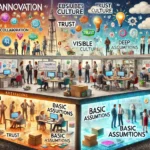Have you ever worked at a company where no one really knows who has the final say in decisions?
Or, on the flip side, have you been in an organization so bureaucratic that even a simple decision required approval from ten different managers?
The truth is, organizational design and company structure have a profound impact on employee behavior, decision-making speed, and ultimately, business success.
🔹 If the structure is well-designed, teams work more efficiently, innovation thrives, and the company scales faster.
🔹 But if the structure is flawed, the organization turns into a slow, frustrating bureaucracy—where neither employees are happy nor customers are satisfied!
🔹 But what exactly is organizational design?
🔹 Why are some companies hierarchical while others operate with a flat, startup-like structure?
🔹 Which model is best for business growth?
In this post, we’ll explore how organizational design influences organizational behavior (OB) and how companies can choose the best structure for their needs.
What Is Organizational Design and Why Does It Matter?
🔹 Organizational design is the process of defining roles, teams, decision-making processes, and how a company evolves.
When it’s done right:
✅ Roles are clear. Employees know their responsibilities and what to expect from each other.
✅ Decision-making is faster. Companies with a well-structured design don’t need ten layers of approval for every minor decision.
✅ Teams work more productively. When hierarchy and communication are clear, work gets done more efficiently.
But if the design is flawed:
🚨 Decisions become slow and bureaucratic.
🚨 Employees feel like their work lacks purpose and lose motivation.
🚨 Innovation gets stifled because no one knows how to turn ideas into action.
So, if you want to build a successful organization, you need a structure that boosts efficiency, keeps employees engaged, and satisfies customers.
Types of Organizational Structures and Their Impact on Employee Behavior
🔹 Different companies adopt different structures based on size, industry, and corporate culture.
🔹 Each structure has its own strengths and weaknesses, influencing how employees interact and perform.
Hierarchical Structure – The Traditional Model
📌 Characteristics:
✅ A top leader makes the key decisions, with authority trickling down the chain.
✅ Every employee reports to a direct manager, who in turn reports to a higher-level manager.
✅ Decision-making is centralized and follows strict rules.
📌 Impact on Organizational Behavior:
✅ High level of order and clarity. Everyone knows their reporting lines and who to take instructions from.
❌ Bureaucracy slows things down. Employees often need to navigate multiple approvals for even small tasks.
❌ Less room for innovation. Decisions flow from the top, leaving lower-level employees with little autonomy.
📌 Examples:
🔹 Banks, government agencies, large manufacturing firms like Toyota.
Flat Structure – The Startup Model
📌 Characteristics:
✅ Few management layers, sometimes with no middle managers at all.
✅ Decision-making is decentralized and team-driven.
✅ Communication is more open and direct.
📌 Impact on Organizational Behavior:
✅ More flexibility. Employees feel empowered to take initiative and execute ideas quickly.
✅ Higher innovation. Teams can experiment and iterate faster.
❌ Potential confusion. Without a clear hierarchy, it’s sometimes unclear who makes the final decisions.
📌 Examples:
🔹 Certain Google teams, startups, creative companies like IDEO.
Matrix Structure – Overlapping Teamwork
📌 Characteristics:
✅ Employees work across multiple teams at the same time.
✅ One person may report to two different managers (e.g., both a project manager and a department head).
✅ Teams are composed of specialists from different fields collaborating on shared goals.
📌 Impact on Organizational Behavior:
✅ Improved cross-team collaboration. Employees work closely with people from other departments.
✅ More flexibility. Employees contribute to multiple projects, increasing adaptability.
❌ Risk of conflicts. Reporting to two managers can create competing priorities.
📌 Examples:
🔹 Large tech companies like Microsoft, Boeing, Tesla.
Which Organizational Structure Is Best?
🔹 Short answer: It depends!
✔ Large, traditional companies like banks often stick to hierarchical structures for control and stability.
✔ Startups and creative businesses often prefer flat structures to maintain speed and agility.
✔ International corporations may use a matrix model to coordinate across global teams.
🔹 Key takeaway: Organizations are always evolving!
✔ A startup might begin with a flat structure but later introduce more hierarchy as it scales.
✔ The best approach is to continually adapt the structure based on business needs and employee behavior.
Organizational Design: A Growth Engine or a Roadblock?
✔ Organizational design isn’t static—it must evolve as the company grows.
✔ Structure directly impacts employee behavior, innovation, productivity, and even job satisfaction.
✔ The best structure is the one that optimizes efficiency, motivates employees, and keeps customers happy.
💡 Now it’s your turn!
In your work experience, which organizational structures have you encountered? Which one do you think works best? Let’s discuss! 😊
This translation maintains the engaging, conversational tone of the original Persian text while ensuring clarity and readability for an English-speaking audience. Let me know if you’d like any refinements! 😊










